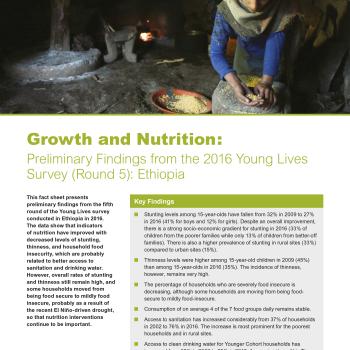Publication Information

Round 5 Longitudinal Growth and Nutrition Fact Sheet
This fact sheet presents findings from the fifth round of the Young Lives survey of children in Ethiopia.The data show that indicators of nutrition have improved with decreased levels of stunting, thinness, and household food insecurity, which are probably related to better access to sanitation and drinking water. However, overall rates of stunting and thinness still remain high, and some households moved from being food secure to mildly food insecure, probably as a result of the recent El Niño-driven drought, so that nutrition interventions continue to be important.
Key Findings:
Thinness levels were higher among 15-year-old children in 2009 (45%) than among 15-year-olds in 2016 (35%). The incidence of thinness, however, remains very high. The percentage of households who are severely food insecure is decreasing, although some households are moving from being food-secure to mildly food-insecure. Consumption of on average 4 of the 7 food groups daily remains stable. Access to sanitation has increased considerably from 37% of households in 2002 to 76% in 2016. The increase is most prominent for the poorest households and in rural sites. Access to clean drinking water for Younger Cohort households has increased from 53% in 2002 to 69% in 2016. Access in sites within Tigray, however, decreased from 45% in 2002 to 29% in 2016.

Round 5 Longitudinal Growth and Nutrition Fact Sheet
This fact sheet presents findings from the fifth round of the Young Lives survey of children in Ethiopia.The data show that indicators of nutrition have improved with decreased levels of stunting, thinness, and household food insecurity, which are probably related to better access to sanitation and drinking water. However, overall rates of stunting and thinness still remain high, and some households moved from being food secure to mildly food insecure, probably as a result of the recent El Niño-driven drought, so that nutrition interventions continue to be important.
Key Findings:
Thinness levels were higher among 15-year-old children in 2009 (45%) than among 15-year-olds in 2016 (35%). The incidence of thinness, however, remains very high. The percentage of households who are severely food insecure is decreasing, although some households are moving from being food-secure to mildly food-insecure. Consumption of on average 4 of the 7 food groups daily remains stable. Access to sanitation has increased considerably from 37% of households in 2002 to 76% in 2016. The increase is most prominent for the poorest households and in rural sites. Access to clean drinking water for Younger Cohort households has increased from 53% in 2002 to 69% in 2016. Access in sites within Tigray, however, decreased from 45% in 2002 to 29% in 2016.

